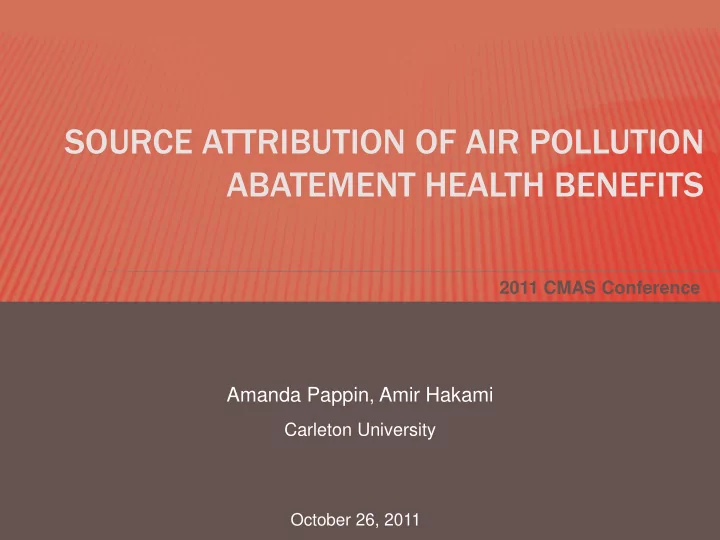

SOURCE ATTRIBUTION OF AIR POLLUTION ABATEMENT HEALTH BENEFITS 2011 CMAS Conference Amanda Pappin, Amir Hakami Carleton University October 26, 2011 1
OPTIMAL CONTROL STRATEGY DESIGN What are the impacts of specific emission sources on: • Climate change (GHGs)? • Air quality and human health (criteria pollutants)? • Sensitivity questions by nature • Backward (adjoint) sensitivity modeling can provide an answer if health benefit assessment tools are integrated with air quality modeling 2
PRESENTATION OVERVIEW • Backgr groun und Estimating health benefits Adjoint sensitivity analysis • Results ults Health benefit sensitivities • Potential ential policy licy applications plications 3
BACKGROUND
HEALTH BENEFITS IN CANADA Air Qua uality lity Benef nefits its Assess essment ment Tool l (AQBA QBAT) T) • Criteria Air Contaminants: PM 2.5 , O 3 , NO 2 , SO 2 , CO • Monetary valuation of health endpoints to allow for benefit-cost analysis → dollar benefits (Modified from Health Canada, 2008) 5
ADJOINT SENSITIVITY ANALYSIS Es Estimating timating the e impa pacts cts of indiv dividu idual l sourc urces es on huma man n health alth Backwar ard d (Adjoint) joint) Ana nalysi ysis Δ x i=1,N Δ y j 𝜀𝑧 𝑘 𝜀𝑦 1,𝑂 Sensitivity: • Sensitivity of a small number of outputs with respect to a large number of inputs • Receptor-based but differentiates between source impacts 6
MAKING USE OF ADJOINT SENSITIVITIES Sens nsiti itivi vity y of what? at? • Mortality in Canada (integrated across receptors) Sens nsiti itivi vity y to what? at? • Anthropogenic NO X emissions at each location ∆$ ∆𝐷 AQBAT Sensitivity: ∆$ ∆𝑭 → Combined ned Sensitivit itivity: y: ∆𝐷 ∆𝐹 CMAQ-Adjoint Sensitivity: 7
ADJOINT TERMS Adjoint oint cost t funct nction: ion: 𝐾 = 𝑁𝑝𝑠𝑢𝑏𝑚𝑗𝑢𝑧 = 𝑁 𝑂 𝐾 = 𝑁 0 𝑗,𝑘 ∙ 𝑄𝑃𝑄 𝑗,𝑘 ∙ 𝛾 𝑃 3 ∆𝐷 𝑃 3 𝑗,𝑘 + 𝛾 𝑂𝑃 2 ∆𝐷 𝑂𝑃 2 𝑗,𝑘 𝑗,𝑘=1 Adjoint oint forcing cing term rm: ∆𝑁 ∆𝐷 ≈ 𝜀𝐾 𝜀𝐷 = 𝑁 0 ∙ 𝑄𝑃𝑄 ∙ 𝛾 VSL VSL = $5.5M (2007 CAD) D) 𝛾 𝑃 3 = 8.39 ∙ 10 −4 𝑞𝑞𝑐 −1 1-hr maximum 𝛾 𝑂𝑃 2 = 7.48 ∙ 10 −4 𝑞𝑞𝑐 −1 24-hr average 8
MODELING CASE Contin ntinental ntal domain omain • 36 km resolution • 13 vertical layers • Gas-phase CMAQ-Adjoint • July-September 2007 modeling period (90 days) 9
SENSITIVITY RESULTS
DAILY HEALTH BENEFITS: O 3 MAX = $33.8 .8 M/DAY, MONTREAL 11
DAILY HEALTH BENEFITS: NO 2 MAX = $32.5 .5 M/DAY, TORONT0 12
TOTAL DAILY HEALTH BENEFITS MAX: $41. 1.7M/D 7M/DAY, MONTREAL ATLANTA & HOUSTON = $1.1M/DAY, LOS ANGELES = $0.6M/DAY 13
VARIABILITY IN HEALTH BENEFITS MAX = $42M/day, MONTREAL MAX = $245M/day, TORONTO MAX = $105M/day, MONTREAL MAX = $275M/day, MONTREAL 14
DAILY UNIT REDUCTION HEALTH BENEFITS MAX: $3,400/D 00/DAY, MONTREAL TORONTO = $1,100/DAY, OTTAWA = $1,500/DAY 15
EFFECT OF AVERAGING PERIOD in terms of sign 1-hr Maximu imum m O 3 24 24-hr Average rage O 3
POLICY APPLICATIONS
1. PUBLIC TRANSPORTATION SYSTEMS Wh What at are e the e health alth benef enefits its of the e Toront onto o subway syst stem em? • Annual vehicle reduction (@ 11,000 miles/vehicle-yr): → 302,000 • NO X emissions reduction → 2,000 tonnes/yr (2007 ) • $1,100 benefit/day per 1 tonne NO X reduction in Toronto $800M benefit/ it/yr yr compared ared to with thout out the subway syst stem em 18
2. PERSONAL VEHICLES Wh What at is the e health alth cost st associat sociated d with th perso sonal nal vehicles ehicles in major jor Canadi nadian n citie ies? s? • 1 tonne NO X /yr ≈ 110 vehicles (2007) • Toron o: $3,800 onto: ,800/yr yr per vehic icle le • Otta tawa: : $5,000/yr yr per vehicle cle • Montreal: treal: $11,0 ,000/ 0/yr yr per vehicle le 19
3. CAP-AND-TRADE Wh What at is the e Benef nefit it-to to-Permit rmit Cost st ratio tio for r a Canadian nadian power er plant ant opera perating ting unde der r NO X cap-and nd-trade trade? NO X permit price in the U.S. (2009) ≈ $2,000/tonne NO X /yr Nanticoke Generating Station, Ontario → 2,760 MW coal-fired power plant → 38,000 tonnes NO X /yr emitted → $1,100 benefit/day per tonne NO X Health alth be bene nefits its are 200 times mes the cost t of emissions issions permits! mits! 20
CONCLUDING REMARKS • He Healt lth h benefits nefits are e vastly stly under dervalue alued d in current rrent regulat gulator ory y frame ameworks rks • Inter erco conti ntine nental ntal trans anspo port t does es not t tell l the e whole ole stor ory • There ere is benefit nefit to be seen en from om Canadian nadian pollution llution contr ntrol • The e sour urce ce-spec specif ificit icity of adjoi joint nt modelin odeling g mak akes es it very y rele levant nt to policy licy decisi cision on-mak makin ing 21
FUT FUTURE URE RES ESEA EARCH CH • Sectoral analysis of health benefits • Taking advantage of temporal variability in health benefit sensitivities 22 22
Ackn knowled wledgeme gements: nts: Stan n Jud udek ek Health Canada Fun undi ding: ng: National Science and Engineering Research Council THANK YOU FOR YOUR ATTENTION
Recommend
More recommend